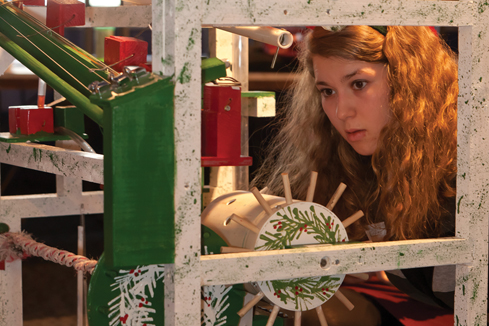 Spring 2012
Spring 2012|
“Over the course of weeks and months that they’re building, they learn how to apply science to solve problems.”
- Linda Ortenzo, Carengie Science Center’s Director of STEM ProgramsPhotos: Renee Rosensteel
|
Domino Effect
At Carnegie Science Center, a rollicking competition starts a chain reaction of science learning.
In the center of a classroom at Carnegie Science Center stands a six-foot-tall frame of wood decorated with brightly colored circus kitsch. Behind it stands a clown with a mallet and, at a ringmaster’s signal, he strikes a musical triangle—the kind used to call an audience’s attention. The triangle knocks a ball bearing down a chute, which triggers a domino effect of the circus toys: A bottle of colored water fills up, then fires like an elephant’s salvo; cars bump each other into action; tiny trapeze lines act as pulleys.
Students from more than 40 schools, some as far away as Cleveland, competed in the Chain Reaction Contraption contest.Each element catalyzes the next until, at the final moment, victory: A small guitar pick is dragged across the strings of a lute, playing one almost inaudible chord, and applause roars from the full room of spectators. It’s a lot of effort—29 steps and two minutes—for seemingly not a lot of payoff. But that’s the point. This device is Bay High School’s contribution to the annual Chain Reaction Contraption contest, a competition among high school students organized by Carnegie Science Center, the Engineers’ Society of Western Pennsylvania, and Westinghouse Electric Company, which is also the main sponsor. The goal is to create the most complicated series of physics feats possible to complete one incredibly simple task. And while it’s fun, and at least a little bit silly (hence the circus theme), the end result could be of the highest importance to these kids’ futures—and, perhaps, to the region. “The serious part is that this is all about STEM [science, technology, engineering, and math],” says John Radzilowicz, director of science and education at the Science Center. “It’s about learning these skills and applying them, and discovering that a future in STEM is fun, lucrative, and that these careers exist right in this region.” For 11 years, the Chain Reaction Contraption Contest has brought together dozens of schools from a broadly defined region (Bay High, for example, is from the Cleveland area). Each year, a team of volunteer Westinghouse employees, Engineers’ Society alumni, and Science Center educators issue a challenge to participating students to build a machine that could accomplish a task—this year’s challenge: play a musical instrument—in a minimum of 20 steps using the basic laws of physics. After months of building, the students bring their contraptions to Carnegie Science Center where professional engineers judge them on their complexity, reliability, and creativity.
“On any given day, we’d have nine people working on the machine,” says Alex Moorhead, a senior at Bay High School and “ringmaster” of the school’s 14-student contraption team. “Early planning was key; we had groups working on stages and each step had to be proven to work reliably before it’d be put into the system. Most importantly, we couldn’t be afraid to scrap things that didn’t work.” It’s just the kind of thinking the Science Center and Westinghouse want to inspire in young minds: the organizational skills, as well as the fun, that makes engineering an exciting educational and career pursuit. As part of the contest, students create plans, document their progress, and design a presentation, just like professional engineers. “This is an opportunity for kids to engage in experiences in STEM that they couldn’t do anywhere else,” says Linda Ortenzo, the Science Center’s director of STEM programs. “Over the course of weeks and months that they’re building, they learn how to apply science to solve problems.” Moorhead and his classmates formed a dedicated extracurricular group and won the contest three years ago. But of the more than 40 schools that registered for the contest in 2011—the most ever—only a handful have comparable resources and experience. At the other end of the spectrum is Penn-Trafford High School from Pittsburgh’s east suburbs. The five students who made up its team— creating a collection of children’s toys that played a xylophone and tuning fork in 21 steps—aren’t part of a class or club. They met through the school’s gifted program and applied for participation to the contest on their own. The majority of their work occurred at a student’s house, not at school.
And while it may seem a long way off to some of the students, the career potential of engineering is huge. “Engineering isn’t always the ‘cool’ thing to do at school,” notes Chris Savinda, Westinghouse’s coordinator for the contest. “A contest like this makes it a lot cooler. And from Westinghouse’s perspective, we’re starting to engage that next generation of individuals in what engineering really is.” Many of the students participating in the contest won’t go on to careers in STEM subjects. But plenty do, including Adam Speicher, a senior at Seneca Valley Senior High School. “I’ve known for a while that I wanted to do something in science or engineering,” says Speicher, whose team created a marble madness- themed contraption that played off of the team’s interest in physics. “This contest helped me figure out which aspects of that work appeal to me—drawing, planning, building.”
|
Crossroads of Culture · Picturing Me · Unpacking Andy · The Galloping Ghost of the East Coast · President's Note · NewsWorthy · Face Time: Kota Yamazaki · Artistic License: For Nature's Sake · First Person: Dine and Discuss · The Big Picture
 |
Copyright © 2017 CARNEGIE Magazine. All rights reserved. |



